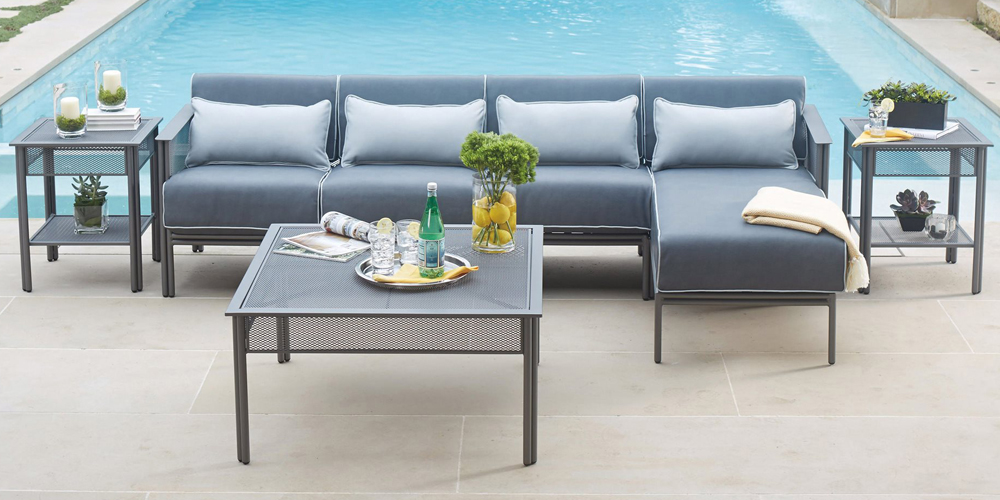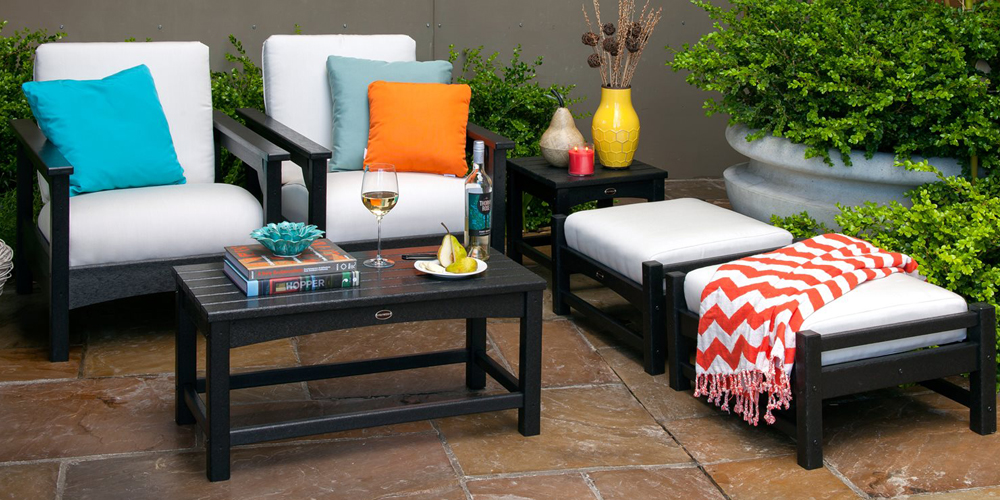


Outdoor cushions not only enhance the style of your patio, they provide support so that you can enjoy sitting and lounging in the open air for long hours. The addition of outdoor cushions to seating makes your outdoor space a true extension of your indoor home, adding coziness to outdoor spaces. It is advised to use the same cushions manufactured by the manufacturer of your outdoor seating, however PatioLiving offers what to look for in cushions construction, size, features, and maintenance when selecting outdoor cushions.
PatioLiving recommends purchasing the cushions that have been specially made by the manufacturer of your seating. This ensures the perfect fit cushions that will best suit the designs of specific furniture. As a general guide to sizing outdoor cushions, measurements will estimate the correct size cushions for outdoor seating furniture.
Width: Use the widest measurement when measuring left-to-right (or arm-to-arm) to find the correct width. This measures left-to-right distance across the seating surface.
Depth: Measure from the front edge of seat to the rear of the seat. This measures front-to-back distance across seating surface.
Back: Measures from the base of the seat to the top of the back.
Height: The height refers to the relative thickness of the cushion. You can estimate the ideal height of your cushions by measuring from the the base of the seat, to the ideal height of where you’d like the cushion to land.


Outdoor cushions are specially constructed to endure in outdoor settings, including exposure to moisture, wind, and sun. Outdoor cushions that are constructed from high-quality materials are resistant to mold, mildew, and fading due to fabric that is quick-drying. The type of upholstery fabric and filling used in outdoor cushions will help to determine its comfort and durability.
The upholstery fabric is the exterior material that surrounds and protects the interior cushion fill. Because upholstery fabric is exposed to the elements, as well as the component of the cushion that provides aesthetic value, look for fabric that is both fade-resistant and waterproof. Read through for a breakdown on the most common upholstery fabrics used for outdoor cushion construction:
Sunbrella Fabric
Cotton Canvas Fabric
Duck Cloth Fabric
Textilene Fabric
Olefin Fiber Fabric
Vinyl Fabric
Batting is used to bring a smooth appearance to cushions. Foam is used as the center core and is then wrapped with batting made from Dacron. These types of cushions carry a medium to firm density.
Avaialable in a variety of densities, foam is the most common filling material applied to fill outdoor cushions. Density is the most important property to consider when choosing foam. Different applications will require different densities of foam. There are 4 important factors that determine the quality of foam used for cushions:
Density: Typically, the higher density the foam, the firmer the cushions will be. Density measures how much air is in the foam. A very high density is considered excessive for outdoor applications. The industry standard for outdoor cushions is between 1.5-1.8 lbs./cu. ft. for seats. Indoor applications require a much higher density for longevity.
Indentation Force Deflection (IFD): IFD is a measurement of a foam’s softness. Indentation force deflection tests how many pounds foam takes to compress. 70 IFD is considered firm, 40-45 IFD is medium, and 33-35 IFD is rated as medium soft.
High Resilience (HR): High resilience foam refers to properties in foam that allow it to quickly regain its shape, or “bounce back” after pressures has been applied. HR foam is better suited for indoor applications, as moisture and exposure from an outdoor setting may compromise the properties of high resilience foam.
Biocide: A biocide treatment is recommended for foams used in outdoor cushions. Biocide is an additive that reduces fungus growth in foam.
The most common types of outdoor cushion foam include:
Compressed Polyester Foam
Polyester Fiberfill Foam
Polyurethane Foam
Open Cell Foam
Closed Cell Foam
Ties
Ties allow outdoor cushions to be attached directly to outdoor seating and keeps them in place even after use
Slip Cover
Slip covers work like ties, but bring a unique aesthetic quality to outdoor furniture. A matching slip cover which covers the frames of outdoor furniture, bringing an all-over fabric covering to frames. This brings a cohesive, aesthetic appeal where the cushion is fastened in place with a pocket flap and industrial grade Velcro for a well-tailored outdoor look.
Foldable
Foldable cushions are single cushions that feature seaming which attach the back and seat cushions together. This single-piece cushion is well suited for storage.
Reversible
Quick aesthetic changes are possible with reversible cushions. They allow customers a simple and versatile style change in a flash by offering different patterns and colors in the same cushion.



